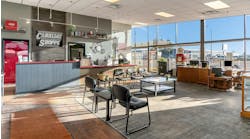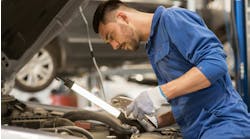Bob Nigra began his long, 25-year career in the automotive industry when he first started pumping gas for his father. He quickly moved into different automotive departments, including service and fixed operations, before he became the general manager of Scott Honda of West Chester in West Chester, Pa.
Nigra was gifted not too long ago with the chance to make anything he wanted out of a blank slate, or in his case, an empty building.
The owner of Scott Honda approached Nigra after purchasing an empty lot and building next door to the dealership. He said, “OK, what do you want to do with the space?”
Nigra peered more closely into one aspect of his business: the reconditioning shop. His turnaround to get a car in the front line to sell was taking, on average, two weeks. Part of his reconditioning business included the paintless dent repair (PDR) part of the collision repair shop. PDR was the least expensive venture to test out, he says.
So, Nigra “put his toe in the water” by opening the reconditioning shop.
Nigra discovered many business lessons along the way, including a challenge of bringing the PDR business in house along with the rest of the reconditioning shop.
Wasted Time
The problem was waiting, he says. The majority of Nigra’s time in business before the new location was spent waiting on other people to finish the work so he could send it to the customer.
He was waiting on vendors. He was waiting on managers to approve the paintless dent removal done on used cars. He was waiting for PDR technicians to visit the dealership collision repair center to perform work when the weather was nice. He was ramping up costs that could have been money in his pocket because cars were not being sold. Instead, they were held at the dealership awaiting repair work.
Like most dealerships, before a year ago, Nigra was waiting for PDR technicians to come to the dealer to perform work on site.
Filling the Space
Nigra assessed his collision repair center. He decided that while the cost was not exactly “cheap,” the easiest way to fix the problem was to send one of his 10-year technicians to a four-week PDR training program in California.
The education cost Nigra roughly $14,000 for tuition and then more with the additional expense for room and board for his employee.
“The worst that could happen would be for the PDR space not to work and my trained and certified technician can go back to repairing vehicles in the shop,” Nigra says.
Despite the cost and Nigra’s overall expense decreasing, his team has increased sales to the retail customers going through the service lanes. Marketing to those new customers was as simple as adding information to the company’s website and a video of the new center’s process on a dented car, he says.
The technician came back to the dealership and signed a two-year contract with the business, he says. Nigra included a noncompete clause to ensure the technician would not go somewhere else nearby in the market to work for a competitor on Scott Honda’s dime.
In addition to taking on PDR, Nigra assigned the technician the duties of managing the rest of the reconditioning shop. The PDR technician oversees a small team, including two disassembly technicians, and works on minor paint repairs and minor bumper repairs, as well.
Another shop technician is being transitioned over to do estimates and planning for the shop. Eventually, the estimator will go directly to the service center to work on estimates and increase revenue, as well.
Increased Efficiency
Right away, Nigra saw a change in turnaround time for cars to be sold on the front line. The new reconditioning and PDR shop cut the turnaround time in half, from two weeks to one week.
Nigra no longer had to worry about holding costs of cars waiting for dent repairs (each of the 300 cars in the lot has a holding cost of $57 per day). By having his own PDR technician, any type of dent could be fixed at a moment’s notice.
“You have cars that get dings by other car doors hitting it and no one wants to buy a vehicle that has dents in it,” Nigra says.
The PDR technician is also able to work offsite on a case-by-case basis. Currently, roughly two days per week, the PDR technician will drive 40 minutes away to work at a sister store to Scott Honda.
Above all, the collision repair center expenses decreased significantly, Nigra says. Not only did expenses decrease, but the reconditioning shop also produces approximately $15,000 per month, with a gross profit of 65 percent.
Reconditioning Reflection
The separate PDR technician and shop cause a tremendous drop in the body shop’s expenses. For example, if the costs to outsource PDR work prior to the change were $20,000, after bringing it in house, the expenses dropped to around $10,000.
Nigra says he was able to save over half just by moving PDR in house.
Yet, he did not anticipate needing to find more work for his technicians due to the decrease in expenses. Nigra had to turn to finding new avenues of revenue and repair jobs for his staff. He had the staff start “farming” work from the service center and insurance companies.
Technicians go to the service center and discuss the possible paintless dent removal repair to any customers who had dings or scratches in the vehicle. The in-house price for paintless dent removal is only $95 per job compared to an average $395 per repair job with paint.
Nigra had to brainstorm creative ideas to get more work for the shop because the shop is located in an area far from regular hail storms or other severe-dent-causing weather.
“We’re still doing repairs for a hail storm that occurred two years ago,” he says. “To this day, those customers are turning in claims for repairs.”



